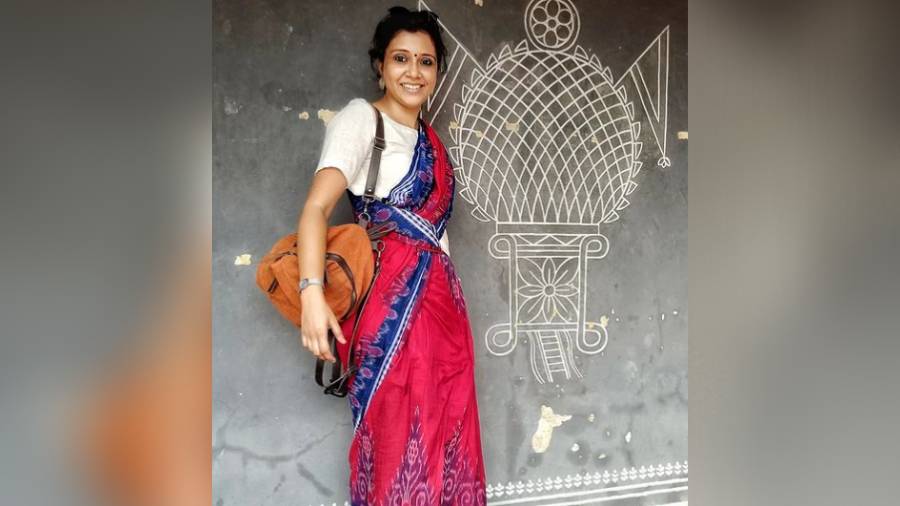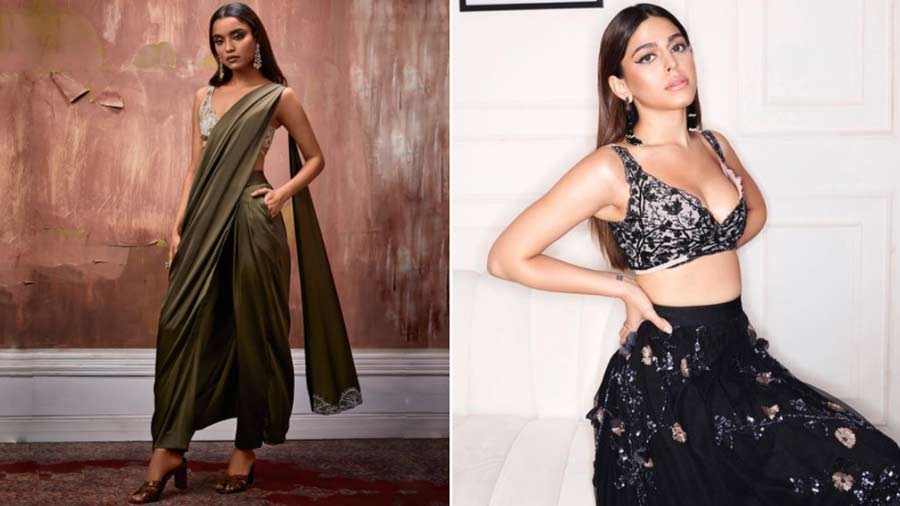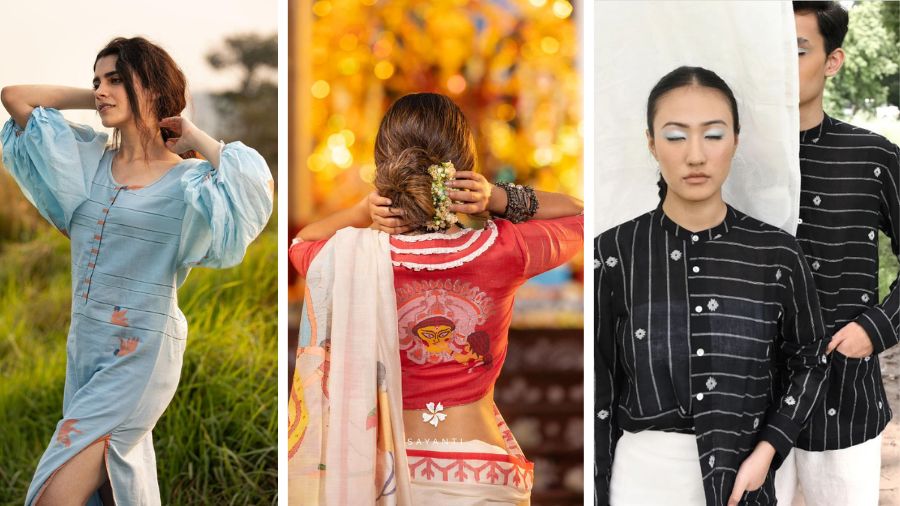Remember Swastika Mukherjee’s classic look during the promotions of Qala? Well, the name behind the actor’s looks is Paromita Banerjee. The Kolkata designer, an alumnus of the National Institute of Design, Ahmedabad, launched her eponymous label almost 13 years ago. Since then, there has been no looking back. Her specially curated handloom weaves and fabrics are elegant and timeless.
My Kolkata had a candid chat with the designer about traditional styles that might be picking up in 2023, all things handloom and more.
The handloom story
Over the last few years, handloom has picked up immensely with more people opting for traditional woven fabrics for outfits — from office wear to traditional and even contemporary formal wear. What brought about the boost?
“People have realised the timelessness of it all — the fact that handlooms and handmade weaves can be timeless. Time could also be a luxury. Things that have passed through hours of work by hand, many months of it — I think that really spoke to people,” said the designer.
Because of Covid, the last couple of years have been terrible for any kind of creative space — be it business, organisations or people working from home. But things really changed when the world suddenly opened up after two years of sitting at home, she said. “I have seen a huge boost because people have started going out again. I feel there is a lot of intimate work happening now, with regard to artistry, history and story. I think that’s where the whole handloom genre has really picked up, especially in the latter half of 2022. I have definitely seen a change.
When asked if the demand will continue, Paromita responded with an enthusiastic “absolutely!”. Elaborating further, she explained that the last five to eight years have seen handloom being introduced to a larger demographic and people began exploring options available in handloom as brands began working with it too. “Of course, our designer-weavers were definitely there, but I saw a lot of brands working on handloom creations at different price points. I definitely see a huge growth in the handloom sector now.”
What trends can we expect in 2023?
The designer admits that she is not someone who follows fashion trends, especially when it comes to the brands. “We follow a slow-fashion process and the idea of the timelessness of fashion, where we prefer each product to pass through multiple hands before it reaches you.”
Paromita has also noticed the revival of older techniques in the field.
“What I have really seen in the latter half of 2022, and now in 2023, is that older techniques are being used. Jamdani is a traditional technique that I think has a lot of unconventional uses. I saw a lot of people were coming in with saris they had at home such as jamdanis, Benarasi katans, Benarasi tissues and were being told that it could be turned into other products like jackets, kimonos and bedsheets. People are realising that things can really be luxurious when they have a story to go along with it. The trends going forward will be older textiles and motifs, along with weaves being revived — a lot of Benarasis are coming into the picture again.”
The sustainability factor
Sustainability in fashion is a major concern in contemporary times. While most labels, brands, or even individuals, describe themselves as practitioners of sustainable fashion, what does the scope of this practice actually entail? And how can people move towards being more conscious of their fashion choices this year?
“I think investing in classic pieces that last through time would really be the scope of sustainability.” According to her, it is the antithesis of what fashion is right now where fashion designers are constantly wanting to get people to buy more. “But I think brands like us really want our customers to slow down and appreciate the value in what they buy. We don’t want our customers to keep buying every single month, year or couple of months.”
She also pointed towards the recent habit, or even addiction, of impulse buying. “Brands are always playing with price points. They are decreasing the price point and making it more lucrative for the consumer. The consumer is buying five instead of the two that they would have otherwise bought. But then, that is also increasing your waste in the market.”
Borrowing BORO
Her own label is completely invested in the practice of ‘BORO’, which was picked up from the Japanese term meaning ‘too good to waste’.
“I think in the Indian repertoire we have always had this technique of jugaad, and recycling and upcycling. Adapting the idea into fashion and textile, I think BORO was one way in which we used up all the fabric leftover we had during weaving. We don’t source from the market, but get our weavers to weave instead. This also helps in reprocessing and restyling our fabrics into different collections,” said Paromita.
Taking BORO out of the confines of the label itself, the designer explained that the method gives people ideas for their own wardrobes at home. “There are times when you don’t want to wear a certain piece after a few years. What do you do? You can repurpose it. You can either cut them up or give it to a designer or brand, who can turn it into a bag, or other items. This also gives people the power to add more value to their items.”
Favourite fabrics and weaves for 2023?
Paromita, who works her magic at her studio near Menoka Cinema Hall at 2B, Lansdowne Lane, said, “Mainly it would be the jamdani. What we have been doing for the past 12 years is reviving older jamdani motifs. We keep the concept of the jamdani the same, so the motifs are the traditional ones, but we contemporise it in terms of the language, colour palette and yarns. Jamdani for us has had a huge scope because we have moved beyond typical muslin jamdani to using matka and zari. We will be making wool jamdani stoles this season as well.”
The label has been working a lot with organic tussar as well. It’s a very tough fabric to weave simply because tussar cocoons are very fragile, said the designer, for whom tussar is the other much-loved weave.
Trends for 2023
What should be retired:
“Impulse buying and ‘Zoom clothes.’ Because people were not going out during the pandemic, many were buying inexpensive clothes that they would just wear during Zoom calls or when attending office virtually. I think those are pieces that you would want to discard. I hope impulse buying will stop as well.”
What should pick up:
“Zari. I see lots of brands exploring zari in a whole lot of ways and now you get Now zari fabrics like zari jamdani, zari matka. This is something we started working with a year ago as well, and wove the zari with the fabric. As a result, the sari or the outfit gives off a metallic look. Even our festive line called Saaj has a lot of woven zari in it. We call them woven gold.”
What should make a comeback:
“I would want to see items with those typical cross stitches, which we used to wear as kids to come back again either in the kids section or in mass-scale fashion. It’s this Parisian-looking embroidery — could be cross stitch or French knots — that you’d find in things that we would buy from Good Companions or New Market’s Laha Store.”
What’s next for Paromita Banerjee, the label
“About two years back, we did a small launch for Chotto Pa, which is our kidswear brand, but we did not have a big launch on the website or the stores where we retail because of Covid. So, our kidswear label will be launched again by the festive season of 2023.”
You can explore more from the house of Paromita Banerjee here.


